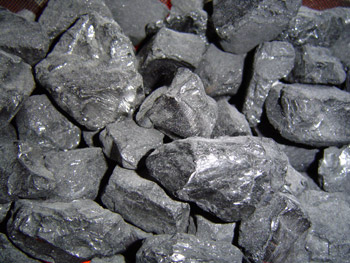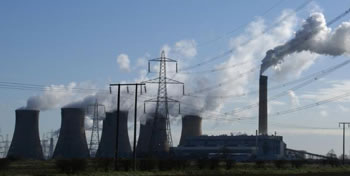Can't see the menu?
Try the text links at the bottom.
Energy Resources:
Fossil Fuels
Fossil fuels:
Energy from fossilised organic materials

|
|
|
|
|
Coal is crushed to a fine dust and burnt.
Oil and gas can be burnt directly.
The main
bit to remember:
Video clip: Fossil fuel power station - how it works |
|
The steam that has passed through the power station's turbines has to be cooled, to condense it back into water before it can be pumped round again. This is what happens in the huge "cooling towers" seen at power stations. Some power stations are built on the coast, so they can use sea water to cool the steam instead. However, this warms the sea and can affect the environment, although the fish seem to like it. |
|
Coal provides around 28% of our energy, and oil provides 40%. Mind you, this figure is bound to have changed since this page was written, so check the figures if you want to quote them. Burning coal produces sulphur dioxide, an acidic gas that contributes to the formation of acid rain. This can be largely avoided using "flue gas desulphurisation" to clean up the gases before they are released into the atmosphere. This method uses limestone, and produces gypsum for the building industry as a by-product. However, it uses a lot of limestone. |
![]() More
details on 'clean coal technology' from BBC News web site...
More
details on 'clean coal technology' from BBC News web site...
Crude oil (called "petroleum") is easier to get out of the ground than coal, as it can flow along pipes. This also makes it cheaper to transport. I ought to point out that some scientists are claiming that oil is not a 'fossil' fuel - that it is not the remains of prehistoric organisms after all. They claim it was made by some other, non-biological process. Currently this is not accepted by the majority of scientists. Natural gas
provides around 20% of the world's consumption of energy, and as
well as being burnt in power stations, is used by many people to
heat their homes. |
Video clip:
What is crude oil? |
Other fossil fuels are being investigated, such as bituminous sands and oil shale. The difficulty is that they need expensive processing before we can use them; however Canada has large reserves of 'tar sands' , which makes it economic for them to produce a great deal of energy this way.
As far as we know, there is still a lot of oil in the ground. But although oil wells are easy to tap when they're almost full, it's much more difficult to get the oil up later on when there's less oil down there. That's one reason why we're increasingly looking at these other fossil fuels.
|
-
Basically, the main drawback of fossil fuels is pollution.
Burning any fossil fuel produces carbon dioxide, which contributes to the "greenhouse effect", warming the Earth. -
Burning coal produces more carbon dioxide than burning oil or gas.
It also produces sulphur dioxide, a gas that contributes to acid rain. We can reduce this before releasing the waste gases into the atmosphere.
 More
details on 'clean coal technology' from BBC News web site...
More
details on 'clean coal technology' from BBC News web site...
-
Mining coal can be difficult and dangerous. Strip mining destroys large areas of the landscape.
-
Coal-fired power stations need huge amounts of fuel, which means train-loads of coal almost constantly. In order to cope with changing demands for power, the station needs reserves.
This means covering a large area of countryside next to the power station with piles of coal.
Fossil fuels are not a renewable energy resource. Once we've burned them all, there isn't any more, and our consumption of fossil fuels has nearly doubled every 20 years since 1900. This is a particular problem for oil, because we also use it to make plastics and many other products. Ok, you could argue that
fossil fuels are renewable because more coal seams and
oil fields will be formed if we wait long enough. That's a long time - we'd have to wait around for longer than the time that humans have existed so far! As far as we today are concerned, we're using it up very fast and it hardly gets replaced at all - so by any sensible human definition fossil fuels are not renewable. |
|

Home Fossil Fuels Nuclear Power Solar Power Wind Power Tidal Power Hydroelectric Power Pumped Storage Wave Power Geothermal Power
Biomass Biogas Other Biofuels See also "Stuff to do" on the home page.
This site uses images from www.freefoto.com and www.sxc.hu I am not responsible for the content of external sites linked from this page.

